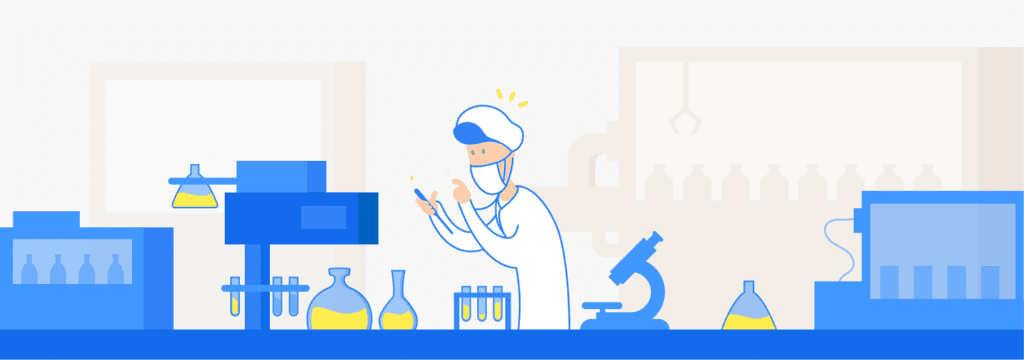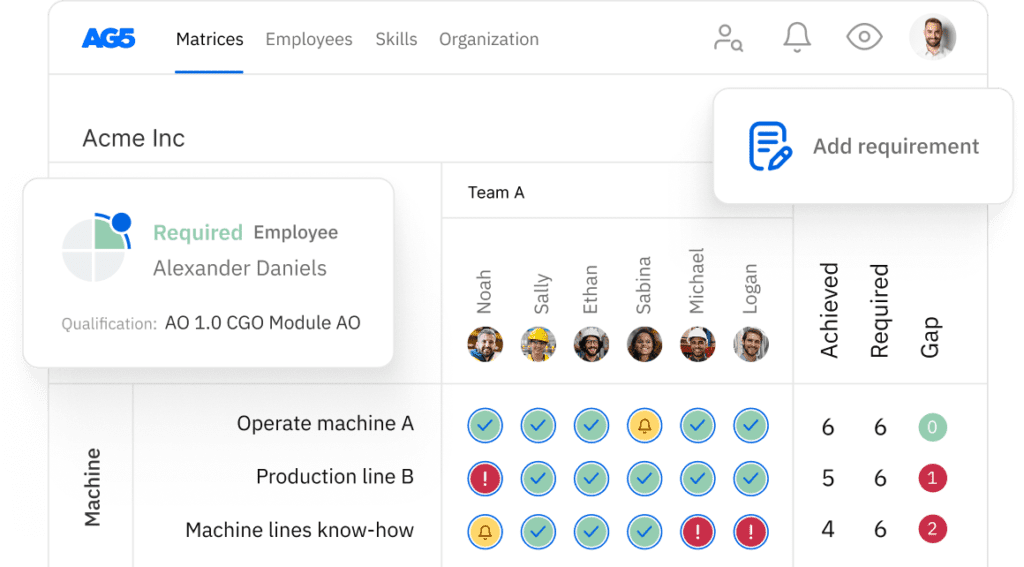Skills & competences: But what’s the difference?
During this article, we explain the distinction between skills and competences, shedding light on their definitions, how they’re developed, and their significance in professional contexts.

Most HR and L&D professionals use the terms skills and competencies interchangeably. But here’s the reality: they’re not the same – and confusing the two can lead to misaligned training, inconsistent performance expectations, and flawed compliance strategies.
What are skills?Copied
Skills are teachable, measurable abilities that enable an individual to perform a specific task – they answer “Can you do this?”
In simple terms, a skill is something you can learn, test, and track. From operating equipment to writing a report, skills form the building blocks of job performance.
They’re typically gained through education, experience, or targeted training.
There are two main types of skills:
- Hard skills. These are technical and often role-specific, like coding in Python, performing first aid, or operating a forklift
- Soft skills. These relate to interpersonal capabilities, such as critical thinking, negotiation, or emotional intelligence
A well-managed organization identifies, tracks, and develops both. In fact, tools like a skills matrix are ideal for visualizing who has what skills, where the gaps lie, and how to link those gaps to training.
More importantly, using a skills management software enables real-time insight into skills across roles, locations, and teams – eliminating the manual chaos of spreadsheets.
For deeper clarity, visit our guide on the types of skills every team should map and track.
What are competencies?Copied
Competencies are broader behavioral frameworks that combine skills, knowledge, and attitudes. They answer, “How do you perform this role in context?”
Unlike skills, competencies go beyond technical know-how. They reflect how an individual applies their skills in real-world, often complex, environments.
Competencies integrate skills, experience, mindset, and values, making them a richer, more strategic element in workforce planning.
For example:
- A skill is being able to create a financial report
- A competency is financial acumen, which includes the ability to create reports, interpret data, make informed decisions, and communicate financial insights clearly
Competencies are often categorized into:
- Behavioral competencies, like leadership, initiative, or collaboration
- Functional competencies, related to specific job functions or roles
- Core competencies, or essential traits shared across all employees (e.g. ethics, problem-solving)
Competencies are especially vital when building or refining a competency framework, ensuring consistency in hiring, evaluation, training, and succession planning.
In compliance-sensitive industries, competencies also play a critical role. You may have technically skilled staff, but do they demonstrate the judgment, reliability, and behavior expected under regulatory scrutiny?
To understand more, explore our detailed breakdown of competence meaning in the workplace.
Competences – 10 examples
Perhaps you’re left feeling that the definition above is a little vague, theoretical, or abstract. So, let’s illustrate the term ‘competence’ further using a few examples. Here are ten for starters:
- Adaptability: an ability to act effectively even in the face of changing working conditions, tasks, and responsibilities
- Communicativeness: an ability to express oneself fully, both verbally and in writing, to formulate ideas clearly and concisely, and to communicate and present these to others.
- Engagement: a state of being whereby an individual feels connected to the task they are performing or a profession they practice, and in doing so have a positive effect on others around them.
- Collegiality: an ability to take into account the needs and interests of other people in an individual’s working environment.
- Rallying Ability: an ability to garner people’s support to achieve an objective or to bring about change, and to turn potential resistance to new plans or reforms into a positive force for change.
- Learning Ability: an ability to take on, analyze, and process new ideas quickly and easily, and to apply these immediately in a work setting.
- Networking Skills: an ability to establish, nurture, and cement working relationships, coalitions, and partnerships, both inside and outside the organization.
- Leadership: an ability to unify and steer a group of people, and to establish and maintain enduring partnerships.
- Resilience: an ability to perform effectively even under pressure and/or in the face of setbacks and opposition.
- Self-Reflection: an ability to see one’s strengths and weaknesses, convictions, qualities, ambitions, and interests.

Skills – 10 examples
There are many types of skill, and they can be categorized as practical, academic, or personal. Here are some examples.
- Bandaging: one of the tasks required to perform first aid or care for someone injured.
- Editing: the art of producing readable text and improving existing text.
- Listening: an ability to be patient and understand what someone else is trying to say or express.
- Sales: an ability to convince and persuade in a commercial setting.
- Drawing: a creative art rendering reality in pictorial form.
- Presentation: an ability to verbally convey general and specialist information to an audience – clearly, convincingly, and compellingly.
- Design: a creative art requiring spatial insight.
- Analysis: an ability to dissect problems or issues into bite-sized chunks to better understand the whole.
- Teaching: an ability to impart information or explain a concept to others.
- Programming: an ability to write logical code for creating computer software.
Skills vs competencies: What’s the real difference?Copied
Skills are task-specific capabilities; competencies are role-specific behaviors that incorporate those skills in action.
At a glance, the difference may appear subtle, but in practice, it’s critical.
| Aspect | Skill | Competency |
|---|---|---|
| Focus | Task or activity | Role performance |
| Scope | Narrow | Broad and contextual |
| Example | Writing code | Problem-solving and collaboration in software projects |
| Development | Training, courses, repetition | Experience, feedback, behavioral reinforcement |
| Measurability | Easily tested or observed | Evaluated through outcomes, behaviors, and context |
Think of a skill as the “can do” and a competency as the “how you do it well.”
For example, a project manager might have the skill to use project scheduling software, but competency means they can lead cross-functional teams, manage risks, and deliver outcomes under pressure.
Understanding this distinction supports more effective:
- Performance reviews. Focusing on both what’s delivered and how
- Talent development. Coaching not just skills but behaviors
- Compliance audits. Proving not just qualification, but capability under real-world conditions.
AG5’s skills proficiency insights help organizations bridge this gap, offering a clearer picture of both capability levels and growth potential across teams.
Why the distinction matters in HR and L&DCopied
Confusing skills with competencies can undermine workforce planning, misguide training investment, and create blind spots in compliance.
In strategic HR and L&D, definitions matter. Here’s how clarity between skills and competencies influences core functions.
Performance management
Using competencies allows you to assess how outcomes are achieved, not just whether tasks were completed. This ensures performance reviews reflect values, leadership behaviors, and consistency under pressure, not merely task fulfillment.
Training design and delivery
Training that targets only skills may ignore underlying behaviors. For example, a safety compliance course might teach protocol (a skill), but not cultivate risk awareness and accountability (competencies). Mapping both ensures training has long-term impact.
AG5 helps link identified skill gaps directly to training interventions, and through competency frameworks, supports alignment of learning with real performance expectations.
Compliance and audit readiness
In regulated industries, having a certified individual isn’t enough. Auditors may ask: Can they apply that knowledge under pressure? Competencies demonstrate this readiness.
AG5’s skills tracking and audit-ready certificate management help prove both skill validity and role-fit competency, ensuring your workforce meets compliance requirements holistically.
When to analyze skills in your workforceCopied
You should analyze workforce skills whenever you need clarity on operational readiness, training priorities, or succession potential.
Skill analysis isn’t just a compliance exercise, it’s a strategic practice for every organization that wants to stay agile, safe, and competitive. Here are the key scenarios when a skills audit becomes essential.
Identifying technical gaps for operational roles
If you’re unsure whether your production teams, frontline staff, or technical roles have the exact skills required for new tools, updated processes, or safety procedures, it’s time for a skills review.
AG5’s skills matrix software simplifies this by showing you instantly who can do what, where critical gaps exist, and who may be underutilized.
Upskilling & succession planning
When preparing team members for future roles or promotions, skill analysis reveals who’s ready, who’s nearly there, and what training is still needed. This allows HR and L&D to allocate development resources with precision, especially important in high-turnover or growth environments.
By using tools like the free skills matrix templates, you can run quick diagnostics without the complexity of full systems, then scale up as needed.
How to conduct a skill gap analysis in Excel (free template)Copied
Excel can be a practical starting point for skill gap analysis, if structured properly. But be mindful of its limitations at scale.
Here’s how to use a simple spreadsheet to identify and close skill gaps across your team.
Step 1: Define roles and required skills
List all roles in your department or team. Then, for each role, outline the essential skills, both hard and soft. This forms your target baseline.
Step 2: Map current skills per employee
Next, assess each employee against the required skills for their role. You can use a 1-5 scale to rate proficiency or tick boxes to show whether a skill is present. This step reveals discrepancies between role expectations and actual capability.
Step 3: Highlight the gaps
Use conditional formatting or a separate column to highlight where a skill is required but missing or underdeveloped. This is your skills gap.
Step 4: Link gaps to training plans
Assign appropriate training or mentoring pathways to each gap. You can even add expiry dates or last review dates to flag areas at risk of compliance issues.
📥 Use our skills matrix template to get started. Designed for clarity, it includes built-in rating scales and training link columns.
Excel: Strengths & shortcomings
| Pros | Cons |
|---|---|
| Easy to start | Manual data entry = error risk |
| Flexible format | No alerts or automation |
| Useful for small teams | Not scalable or audit-friendly |
While Excel works for initial assessments, tools like AG5 offer real-time alerts, expiry tracking, and role-based dashboards, eliminating version control headaches and audit panic.
When to evaluate competencies within teamsCopied
Competency evaluation becomes critical when behavior, judgment, or leadership potential drive success as much as technical ability.
You may know your team can do the job, but how do they perform under pressure? How do they lead, adapt, or collaborate? These questions require a competency lens.
Here are key scenarios where a competency assessment delivers strategic insight.
Leadership pipelines and promotion decisions
Technical proficiency doesn’t guarantee managerial readiness. Competency evaluation uncovers who shows traits like influence, strategic thinking, and resilience – essential for leadership roles.
AG5’s Expert Finder feature helps you identify internal candidates who not only meet the skill requirements, but also demonstrate the soft power to lead and inspire.
Behavioral fit and cultural alignment
Whether you’re hiring externally or reshuffling internally, aligning team behaviors with organizational values ensures smoother integration and fewer conflicts. Competency mapping tools can help you avoid cultural mismatches that skills assessments alone might miss.
Regulated roles and compliance risk
In industries like healthcare, construction, or chemical engineering, compliance doesn’t end with technical certifications. Behavioral competence, such as adherence to protocols, decision-making under stress, and situational awareness, is critical to safety.
Competency evaluation provides assurance that team members are not just trained, but fit-for-role in practice. This level of diligence significantly reduces audit risk and operational exposure.
For a deeper dive into structured frameworks, explore our guide on competency development.
How AG5 supports skills & competency tracking at scaleCopied
AG5 replaces Excel chaos with automated skills and competency tracking, enabling smarter decisions, cleaner audits, and strategic clarity.
Most organizations start with spreadsheets. But as teams grow and compliance demands rise, Excel becomes a bottleneck. AG5 was built to solve this.
Here’s how AG5 elevates your skills and competency management:
Visual matrices & gap alerts
With AG5’s drag-and-drop skills matrix builder, you can map roles, assign skills, and visualize coverage instantly. Gaps are highlighted automatically and linked directly to training or certification actions.
No more guessing, no more “Who’s qualified?” emails.
Certificate track & audit-ready records
AG5 stores certificates centrally and issues expiry alerts via email or SMS. You’ll never miss a recertification deadline again, a critical feature for audit-intensive industries. Full audit trails and access logs ensure readiness under scrutiny.
Competency framework integration
You can build or import competency frameworks, then assess team members through self-assessments, manager reviews, or even peer feedback. Results are logged, analyzed, and visualized across roles and departments, giving HR, L&D, and operations a shared source of truth.
From Excel to insight
Transitioning to AG5 means:
- No version control issues
- Instant access across locations
- Rich analytics dashboards
- Seamless LMS/HRIS integrations
Whether you’re managing a frontline workforce or scaling an enterprise L&D strategy, AG5 ensures your data is centralized, actionable, and compliance-ready.
ConclusionCopied
Understanding the distinction between skills and competencies is a strategic imperative.
Skills show what someone can do. Competencies show how they apply those skills under pressure, in context, and in alignment with company values.
Getting this distinction right helps HR and L&D leaders:
- Design training that delivers real behavioral change
- Build performance frameworks that reward the right outcomes
- Stay compliant with confidence
If you’re looking for the right tools to provide greater clarity about your staff’s skills and competences and to manage and maintain these quickly and easily, schedule a personal demo and dive into the world of AG5!
Use AG5 to identify skill gaps
Say goodbye to Excel matrices. Start using AG5’s plug and play skill matrix software.
ISO27001 certified
Start your 14-day free trial
FAQs Copied
-
What is the main difference between a skill and a competency?
-
Can you have a competency without a skill?
-
Why does this distinction matter in compliance-heavy industries?
-
How often should we review workforce skills and competencies?
-
Is it better to manage this in Excel or with software?

